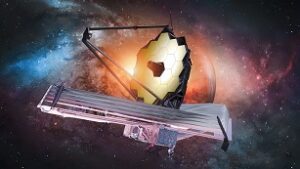Webb Telescope Discovers Ancient: A supermassive black hole found deeper in the universe than ever before by the James Webb Space Telescope has stunned scientists again. CEERS 1019, a 13-billion-year-old galaxy, contains this remarkable black hole. The central black hole’s small size puzzles scientists.
NASA estimates this black hole weighs 9 million suns. Solar mass, the mass of our sun, is 333,000 times that of Earth. It is much smaller than other early universe black holes found by telescopes. They are brighter and have over 1 billion times the mass of the Sun.
The James Webb Space Telescope’s sensitive instruments can detect light so faint that it can focus on a distant black hole. Rebecca Larson, a postdoctoral research associate at Rochester Institute of Technology’s School of Physics and Astronomy, led this discovery. She compares observing this remote object to studying black holes in nearby galaxies.
The researchers found two nearby black holes that formed about 1 billion years after the big bang. These black holes, like CEERS 1019, are lighter than their predecessors. The University of Texas at Austin’s Webb telescope‘s Cosmic Evolution Early Release Science (CEERS) Survey discovered eleven new galaxies.
CEERS 1019, the galaxy with the small black hole, puzzles scientists. The early universe had much larger gravitational wells, so how a tiny black hole formed is unknown. Instead of a disk-shaped formation like most galaxies, CEERS 1019 has three bright spots.


READ MORE: Unveiling Mars: The Colorful Tapestry of NASA First TV Image
Rochester Institute of Technology CEERS team member Jeyhan Kartaltepe comments on the extraordinary structure captured in images at such vast distances. Kartaltepe suggests a galaxy merger may have increased star formation around this galaxy’s black hole.
NASA says the newly discovered galaxies are actively making new stars, suggesting future breakthroughs. These findings and the CEERS survey could change our understanding of star formation and galaxy evolution. Webb’s detection of these galaxies excites UT Austin NASA Hubble Fellow Seiji Fujimoto, who believes this collection and future discoveries could change our understanding of the universe.
Researchers expect the most distant active supermassive black hole, CEERS 1019, to be surpassed soon. NASA estimates that data analysis could identify even more distant black holes within weeks, which the astronomical community eagerly awaits.
Our Reader’s Queries
What was discovered with the James Webb Telescope?
Reviewing the groundbreaking findings of the JWST in 2023, we have witnessed a paradigm shift in our comprehension of the cosmos. This innovative telescope has provided new insights into our own solar system and uncovered the presence of life-sustaining molecules on a nearby exoplanet. Additionally, it has successfully identified the smallest object to date, as well as revealing enigmatic galaxies in the early stages of the universe. Truly, the JWST has surpassed expectations and expanded our knowledge of the universe in remarkable ways.
What did the James Webb Telescope find out?
NASA’s James Webb Space Telescope recently probed K2-18 b, an exoplanet 8.6 times the size of Earth, and uncovered the existence of carbon-based compounds such as methane and carbon dioxide.
Did the James Webb Telescope find the oldest galaxy?
Maisie’s galaxy was spotted using the James Webb Space Telescope, 390 million years following the Big Bang.
What unknown object did the James Webb Telescope see?
The James Webb Space Telescope has found sets of unusual rogue objects drifting through space in pairs. Scientists are baffled by these physics-defying Jupiter-mass binary objects, also known as “JuMBOs,” freely floating in the Orion Nebula. There are a total of 42 pairs of these mysterious objects, and their existence has left researchers puzzled.

